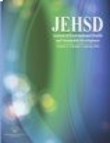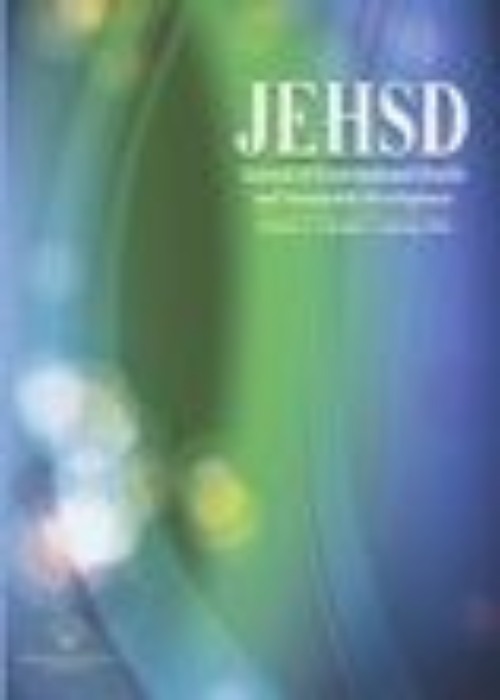فهرست مطالب

Journal of Environmental Health and Sustainable Development
Volume:8 Issue: 4, Dec 2023
- تاریخ انتشار: 1402/09/10
- تعداد عناوین: 8
-
-
Pages 2102-2112Introduction
Since global warming and air pollution was caused by human activities have increased dramatically in recent decades, studies have been conducted to determine how environmental parameters and air pollutants interact and, subsequently, how these pollutants affect ecosystems and human health. Accordingly, this study aimed to investigate the relationship between temperature and air pollutants in Tehran, Iran, in order to determine whether warming is associated with an increase in air pollutants.
Materials and MethodsDuring 2015-2019, Iran Air Quality Monitoring Station (AQMS) and the Landsat 8 satellite were employed to retrieve data on pollutants such as PM, CO, O3, NO2, SO2, and air quality index (AQI), as well as climate-related metrics including ambient temperature and land surface temperature (LST). Pearson correlation coefficient and linear regression model were used to analyze the data.
ResultsA positive correlation was found between temperature variables and PM10 (ρ = 0.29, p = 0.001) and O3 (ρ= 0.55, p = 0.001) pollutants. PM10 and O3 levels were evaluated by 0.46 (95% Confidence Interval (CI) = (0.25, 0.67), p = 0.001) and 1.13 (95% CI = 0.89, 1.37), p = 0.001) units for each one-unit rise in temperature.
ConclusionGiven the fact that temperature predominantly evidenced a significant synergistic association with PM10 and O3, it was determined that there was no substantial positive association between all pollutants and warming.
Keywords: Air Pollution, Global Warming, Climate Change, Temperature, Health -
Pages 2113-2124Introduction
The two main causes of indoor air pollution (IAP) are cooking and smoking. Toxic substances, including polycyclic aromatic hydrocarbons (PAHs), recognized as human carcinogens, are present in cooking and tobacco smoke. This study aims to determine the cytotoxicity and genotoxicity of PAHs collected from the indoor air of coffee shops on human cell line (KB/C152) in vitro approach.
Materials and methodsSampling pumps at a 2 l/min flow rate for 5 hours were applied to collect indoor air samples. Next, KB cells in cell culture medium were exposed to different concentrations of extracted PAHs using Methyl Thiazolyl Tetrazolium (MTT) test. Finally, terminal dUTP nick-end labeling (TUNEL) test and cell cycle assessments were both examined using flow cytometry.
ResultsThe MTT test revealed a significant cytotoxic effect on KB cells depending on the PAHs concentrationas compared to the control cell line. The lethal concentration 50 (LC50) value against KB cells was 100 ± 3.09 µg/ml. Accordingly, exposure to extracted PAHs resulted in an arrest in the cell cycle at the sub-G1 checkpoint. The extracted PAHs suppressed the cell cycle in the sub-G1 phase, damaged DNA, and arrested KB cells from proliferating. Additionally, a statistically significant increase in DNA cleavage percentages (p ≤ 0.05) was seen in the TUNEL test, which also showed a dose-dependent increase in DNA damage.
ConclusionExtracted PAHs caused DNA damage and arrested in the cell cycle in epidermoid carcinoma of the mouth cells (KB/C152) in vitro mechanisms. This evaluation highlights mechanisms of exposure to extracted PAHs and their detrimental health effects.
Keywords: PAHs, Air Pollution, Indoor, DNA Damage, KB, C152 -
Pages 2125-2133Introduction
Given that hospital air is one of the important environmental sources for transmission of microorganisms, the importance of airborne transmission in the epidemiology of hospital-acquired infections (HAIs) has gained attention in the past two decades. Therefore, the present study aims to determine the concentration of bacteria in association with airborne particulate matter (PM) in the outdoor and indoor air of two hospital wards.
Materials and methodsThe GRIMM 1.109 dust monitor and the Andersen one-stage viable impactor were used for particle counting and bioaerosol sampling, respectively.
ResultsThe average levels of airborne bacteria sampled from outdoor air were 33 colony-forming units (CFU/m3), and in the air samples of medical and infectious disease wards, they were 76 and 85 CFU/m3, respectively. Staphylococcus spp. and Acinetobacter spp. were the most prevalent bacteria in the samples. Statistical analysis showed a significant association between PM2.5, and PM10 particle mass concentrations and airborne bacteria concentrations in indoor air samples (P-value < 0.05).
ConclusionSome bacterial agents of HAIs existed in hospital air and may be problematic for immunocompromised patients. Higher levels of bacteria in indoor air compared to outdoor air may indicate that the bacteria were of indoor origin, such as the presence and activities of people. Moreover, the results showed that particle counting may be a useful tool for airborne bacteria monitoring.
Keywords: Aerosols, Bacteria, Particulate Matter, Hospitals -
Pages 2134-2138Introduction
Human infection with Sarcocystis species can be attributed to the consumption of raw or inadequately cooked meat, such as hamburgers, containing encapsulated parasites.
Materials and MethodsThis cross-sectional study was conducted between April and September 2022 in Fouman, Iran. A total of 182 hamburger samples, comprising two types of traditional hamburgers and industrial hamburgers, were collected.
ResultOut of 182 hamburger samples of different types, 34% of them were found to be infected with Sarcocystis spp. The infection rate within industrial and traditional hamburgers was 21.5% and 56%, respectively. Notably, a statistically significant difference was observed between Sarcocystis-infested traditional and industrial hamburgers (p < 0.05). Among the two distinct groups of 182 hamburgers, the microscopic digestion method revealed the presence of Sarcocystis bradyzoites in all 51 infected traditional beef burgers and 19 positive industrial beef burgers. However, in the dab smear method, just 33 and 12 positive samples were respectively identified in traditional and industrial beef burgers and a statistically significant difference was observed between efficiency of these two methods (p < 0.05). Infection with macroscopic parasite cysts was not observed in any of hamburger samples. Similarly, no statistically significant association was identified between the meat content percentage and the infection rate in industrial hamburgers (p > 0.05).
ConclusionConsidering the high abundance of Sarcocysts micro cysts in frozen raw hamburgers, it is recommended to fully cook this food product and avoid consumption when only partially cooked.
Keywords: Sarcocystis, Digestion, Hamburger, Fouman City, Iran -
Pages 2139-2148Introduction
Droughts and precipitation imbalances in various parts of the world have underscored the significance of alternative water resources. In recent years, recycled water has emerged as a viable alternative, with wastewater being treated to a safe level for diverse purposes. However, the public acceptance of water reuse plays a pivotal role in determining the success of recycling initiatives. This study aims to identify the barriers and facilitators influencing public acceptance of water reuse in Yazd, Iran, during 2020.
Material and MethodsA cross-sectional study involving 384 individuals in Yazd city during 2020 was conducted. Participants were selected using the stratified sampling method. The data collection tool was a researcher-made questionnaire. Data were analyzed using descriptive statistics and the Pearson correlation test in SPSS software version 23.
ResultsThe most crucial facilitator for acceptance was the concept of segregating drinking water and recycled water networks. The primary barrier to acceptance was the perceived risk of recycled water contamination and potential health hazards. Water reuse was most widely accepted for construction purposes, followed by toilet flush tanks and irrigation of green spaces in parks and sports fields. A positive correlation (r = 0.416) existed between facilitators and acceptance of water reuse, indicating that enhancing facilitators positively affected acceptance.
ConclusionTo successfully implement water reuse projects, it is essential to consider key facilitators such as segregated water systems for different household uses, raising public awareness about the benefits of water reuse, and building public trust in recycled water safety.
Keywords: Attitude, Public Health, Wastewater, Yazd City -
Pages 2149-2158Introduction
Contamination of water sources with toxins is an environmental problem and a serious threat to the health of societies. This study aimed to ascertain the remaining levels of toxins in urban drinking water networks and compute the water quality index.
Materials and MethodsTo examine the residual concentration of diazinon, chlorpyrifos, and dichlorvos in urban drinking water distribution networks, 35 underground and surface water sources were sampled in Tiran-o-Karvan in Isfahan province, Iran. GC-ECD device was used to analyze the samples.
ResultsDiazinon was not observed in any of the sampling seasons. The maximum concentration of chlorpyrifos and dichlorvos was 61 and 100 ppb, respectively. Although chlorpyrifos was seen more in the hot season and dichlorvos in the cold season, the mean concentration of these toxins in different seasons was lower than the guidelines of Iran and the World Health Organization (WHO). The mean concentration of nitrate, and hardness, in wet and dry seasons was 46.23 and 46.42, and 343.7 and 338.8 mg/l, respectively.
ConclusionThe mean and standard deviation of quality index of Iran's water resources (IRWQI) in wet and dry seasons were 52.16 ± 45.3 and 50.69 ± 15.8, respectively. The residual concentration of toxins in some water sources of this city exceeded the guidelines of Iran and the WHO in summer and spring.
Keywords: Diazinon, Chlorpyrifos, Dichlorvos, Drinking Water, IRWQI, Tiran-Karvan City


